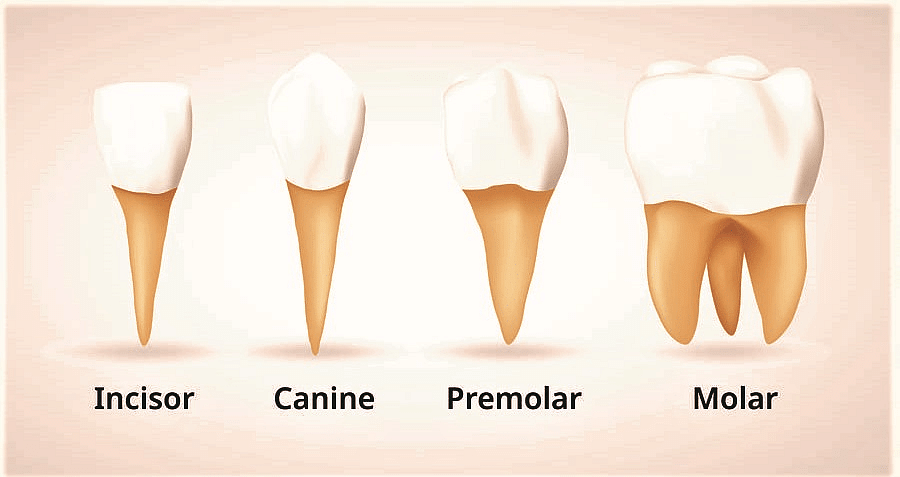Class 10 Science Chapter 5 Practice Question Answers - Life Processes
Very Short Answer Type Questions
Q 1. Define nutrition.
Ans: Nutrition is a method in which food is consumed by the organisms in the body and utilizing the nutrients from the food.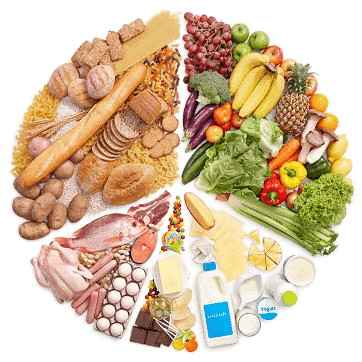
Q 2. Name the enzymes present in the stomach.
Ans: Pepsin is an enzyme that is present in the stomach.
Q 3. Which part of the body secretes bile? Where is bile stored?
Ans: Bile is secreted only by the liver and is stored in the gall bladder.
Q 4. Define peristalsis.
Ans: Peristalsis is a series of wave-like muscle contractions that move food to different processing stations in the digestive tract.
Q 5. What is the emulsification of fat?
Ans: Emulsification is the process that involves the breakdown of large fat globules into smaller globules that are soluble in water.
Q 6. Name the enzyme present in human saliva. What type of food material is digested by this enzyme?
Ans: The enzyme found in human saliva is ptyaline. Ptyaline is also known as salivary amylase. Secreted ptyaline in the mouth causes starch digestion in the mouth itself.
Q 7. Define assimilation.
Ans: The absorption and digestion of food or nutrients by the body or any biological system is known as assimilation.
Q.8. Name the most common method of ingestion in Amoeba.
Ans: Phagocytosis is the most common method of ingestion in Amoeba.
Q 9. Why is the food vacuole of Amoeba called a temporary stomach?
Ans: In amoeba, after the digestion of food in the food vacuole, the food vacuole disappears, and a new food vacuole is created every time. Thus, it is known as a 'Temporary stomach'. 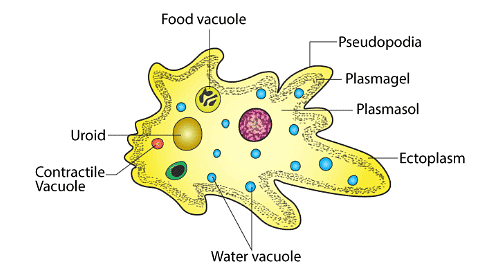
Q 10. Name different types of teeth present in man.
Ans:
- Eight incisors: There are four incisors in the upper and lower jaw. They are meant for cutting.
- Four canines: The pointy teeth on either side of the incisors are canines. They are meant for tearing.
- Eight premolars: They are present next to the canines. They are meant for grinding.
- Twelve molars: They are present at the end of the jaw, next to the premolars. It also includes four wisdom teeth.
 Types of Teeth
Types of Teeth
Q 11. Which part of the alimentary canal is adapted for complete digestion and absorption of food?
Ans: The small intestine is adapted for complete digestion and absorption of food.
Q 12. What is succus entericus?
Ans:
- Succus entericus is the alkaline secretion produced by glands in the wall of the duodenum, consisting of water, mucoproteins, and hydrogen carbonate ions.
- Lieberkuhn's crypts secrete the intestinal juice or succus entericus.
- It helps to counteract the highly acidic and proteolytic chyme entering the small intestine from the stomach and thus protects the duodenum from damage.
Q 13. Name the largest gland of the human body.
Ans: The liver is the largest gland of the human body.
Q 14. Name the protein-digesting enzymes present in the pancreatic juice of man.
Ans: Trypsin is the protein-digesting enzyme present in man's pancreatic juice.
Q 15. What are the end-products of fat digestion?
Ans: Fats are digested in the small intestine. The complete digestion of one fat molecule (a triglyceride) results in three fatty acid molecules and one glycerol molecule. The liver produces bile that helps you digest fats and certain vitamins.
Q 16. Which structure prevents the entry of food particles into the windpipe?
Ans: The epiglottis moves back and forth through the windpipe to prevent the passage of food and liquids into the lungs.
Q 17. Name the factors that affect photosynthesis.
Ans: The factors affecting the rate of photosynthesis are:
- Temperature
- Intensity and wavelength of sunlight
- Carbon dioxide concentration
- Water
Q 18. Write the complete reaction of photosynthesis.
Ans: 6CO2 + 6H2O → C6H12O6 + 6O2
Q 19. Name any two types of pigment present in plants that can absorb sunlight energy.
Ans: Xanthophyll and Chlorophyll are pigments present in plants that can absorb sunlight energy.
Q 20. Name the cellular organelle where the photosynthesis process occurs.
Ans: The chloroplast is the cellular organelle where the photosynthesis process occurs.
Q 21. Give the function of guard cells.
Ans: Guard cells regulate the opening and closing of stomata by intake of potassium ions and water. It helps in the exchange of gases.
Short Answer Type Questions
Q 1. Describe various modes of nutrition.
Ans: Nutrition is mainly divided into two categories:
- Autotrophic mode of nutrition:
(i) Phototrophic: Organisms prepare their own food in the presence of sunlight, water and carbon dioxide.
Example: Green plants
(ii) Chemotrophic: Organisms prepare their own food in the presence of chemicals such as nitrate, hydrogen sulphate, iron, sulphur, etc.
Example: Bacteria - Heterotrophic mode of nutrition:
(i) Holozoic: Animals eat all their food. It includes five stages of digestion: ingestion, digestion, absorption, assimilation, and egestion.
Example: Humans
(ii) Saprophytic: Organisms feed on dead and decaying organic matter. In this mode, organisms first convert the complex food into a simple form and then ingest them.
Example: Decomposers
(iii) Parasitic: Organisms obtain food from other living organisms. In this mode, one organism (parasite) lives inside the other organism (host organism) and derives nutrients from that.
Example: Tapeworm
Q 2. Mention various steps of nutrition in Amoeba.
Ans: Holozoic nutrition is the process of nutrition that takes place in organisms that take solid or liquid food inside their body. Amoeba follow holozoic nutrition.
Holozoic nutrition in amoeba takes place in the following steps:
(i) Ingestion
(ii) Digestion
(iii) Absorption
(iv) Assimilation
(v) Egestion
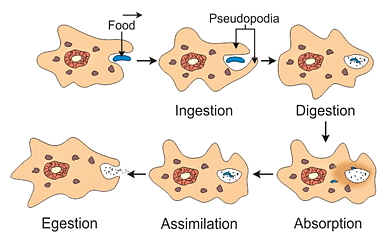
Q 3. Draw the position of salivary glands in the mouth.
Ans:
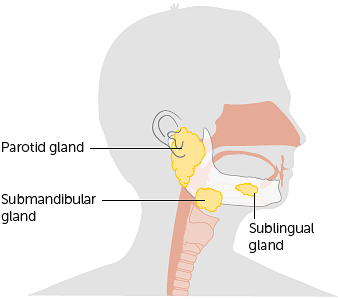
Q 4. What is the role of hydrochloric acid in our stomach?
Ans: Hydrochloric acid makes the environment in the stomach acidic, kills the microbes in the stomach that enter with the food, and provides a desired acidic medium so that the enzyme pepsin can act on the food.
Q 5. State two functions of the large intestine of man.
Ans:
- It stores the waste food materials.
- It reabsorbs water and salts that were left after digestion.
Q 6. What criteria do we use to decide whether something is alive?
Ans: All living organisms are made up of cells and show living characteristics by showing visible movement, such as walking, breathing, or growing. However, a living organism can also have movements that are not visible to the naked eye. But all living cells perform life processes like respiration, nutrition, reproduction, etc. Therefore, the presence of life processes is a fundamental criterion that can be used to decide whether something is alive or not.
Q 7. What are the differences between autotrophic nutrition and heterotrophic nutrition?
Ans:

Q 8. How is the small intestine designed to absorb digested food?
Ans: The small intestine is the most important part of the alimentary canal for digestion and absorption of food.
- It has three regions: a U-shaped duodenum, a long coiled middle portion jejunum, and a highly coiled ileum.
- The innermost layer lining the lumen of the alimentary canal is the mucosa. This layer forms irregular folds (rugae) in the stomach and small finger-like foldings called villi in the small intestine.
- These modifications increase the surface area for more absorption. Villi are supplied with a network of capillaries and a large lymph vessel called the lacteal.
- It transports lipid molecules. The wall of the intestine is surrounded by blood vessels that assimilate food molecules to the different parts of the body.
Q 9. What is the difference between ingestion and egestion?
Ans:
- Ingestion: Taking in complex organic food by the organism is called ingestion.
Egestion: The elimination of undigested waste and food materials from the body is called egestion.
Q 10. How can dental caries be prevented?
Ans: By avoiding food that causes acidity, one can prevent dental caries.
Questions for Self-Practice
Q 1. Look at the figure and identify X. What is its role in plants?
Q 2. Which is the site of Photosynthesis? The given figure shows a section of the leaf as seen under a microscope. What is the role of the waxy layer on the upper epidermis?

Q 3. Look at the figure. Answer the following questions:

(a) What is the need to use potassium hydroxide?
(b) Why do we need two plants?
(c) Why do we cover both plants with polythene sheets or bell jars?
(d) What observation do you expect at the end of the experiment and why?
(e) What is the aim of the activity?
Q 4. If a plant is kept covered with a polythene sheet, we notice some water drops on the inner side of the sheet after some time. What are they due to? Name and define the process. What is the significance of this process in plants and nature? How does transpiration help in the upward movement of water from roots to leaves?
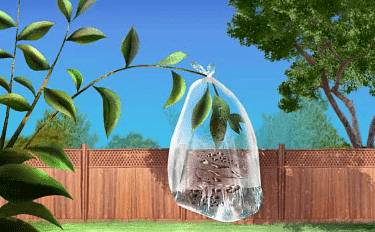
|
85 videos|437 docs|75 tests
|
FAQs on Class 10 Science Chapter 5 Practice Question Answers - Life Processes
| 1. What are the life processes in living organisms? |  |
| 2. What is the importance of nutrition in living organisms? |  |
| 3. How does respiration take place in living organisms? |  |
| 4. What is the role of transportation in living organisms? |  |
| 5. How do living organisms excrete waste products? |  |

|
Explore Courses for Class 10 exam
|

|
